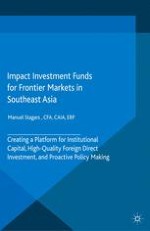2015 | Buch
Impact Investment Funds for Frontier Markets in Southeast Asia
Creating a Platform for Institutional Capital, High-Quality Foreign Direct Investment, and Proactive Policy Making
verfasst von: Manuel Stagars, CFA, CAIA, ERP
Verlag: Palgrave Macmillan UK
Buchreihe : Palgrave Studies in Impact Finance
